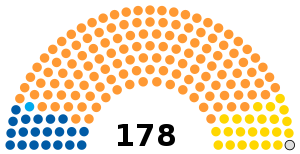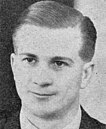South African general election, 1987
|
|
|||||||||||||||||||||||||||||
|---|---|---|---|---|---|---|---|---|---|---|---|---|---|---|---|---|---|---|---|---|---|---|---|---|---|---|---|---|---|
|
|||||||||||||||||||||||||||||
|
All 166 elected seats in the House of Assembly |
|||||||||||||||||||||||||||||
|
|||||||||||||||||||||||||||||

House of Assembly after the election
|
|||||||||||||||||||||||||||||
|
|||||||||||||||||||||||||||||
The 1987 South African general election was held on 6 May 1987. The State of Emergency existing in South Africa at that time cast a cloud over the elections. It was once again won by the National Party (NP) under the leadership of P. W. Botha, although for the first time it faced serious opposition from the right of the South African political spectrum.
The right-wing opposition came in the form of the Conservative Party (CP), which opposed even the limited powersharing with Indian and Coloured South Africans that had been implemented by the NP as part of a package of constitutional reforms in 1984. The CP was led by a former chairman of the Broederbond and NP cabinet minister, Andries Treurnicht, infamously known as Minister of Education under the Soweto riots. Following the election, in which the CP extended its 17 splinter MPs to win 22 seats, it replaced the Progressive Federal Party (PFP) as the official opposition in the House of Assembly.
The election year also saw important political developments to the left of the NP. During 1987 Denis Worrall resigned as the South African ambassador in London to return to politics. Together with Wynand Malan (who had resigned from the NP) and Esther Lategan he formed the Independent Movement to fight the general election. Only Malan won a seat and the partnership consequently disintegrated. Denis Worrall and others subsequently went on to form the Independent Party (IP), while Esther Lategan and others formed the National Democratic Movement.
...
Wikipedia



